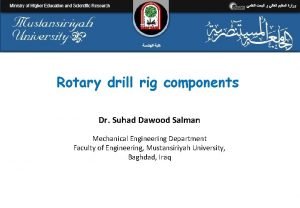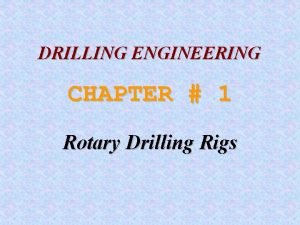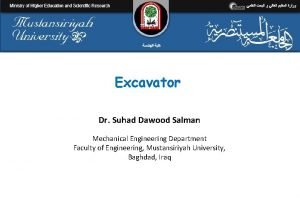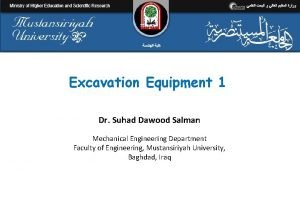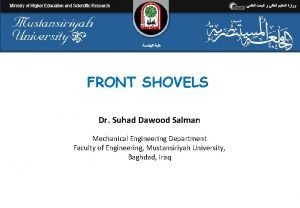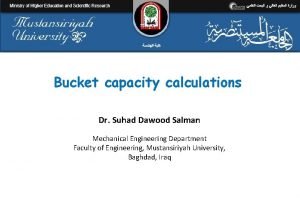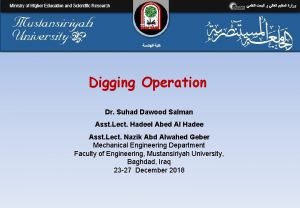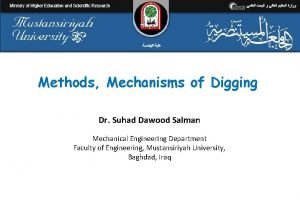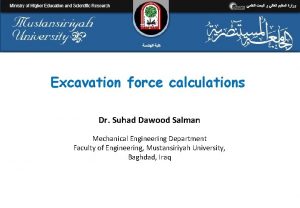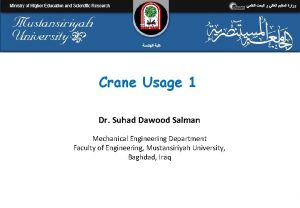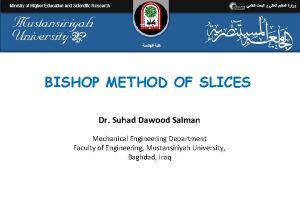Rotary drill rig components Dr Suhad Dawood Salman










- Slides: 10

Rotary drill rig components Dr. Suhad Dawood Salman Mechanical Engineering Department Faculty of Engineering, Mustansiriyah University, Baghdad, Iraq

A drilling rig is a machine that creates holes in the earth's subsurface. Drilling rigs can be massive structures housing equipment used to drill water wells, oil wells, or natural gas extraction wells, or they can be small enough to be moved manually by one person and such are called augers. Drilling rigs can sample subsurface mineral deposits, test rock, soil and groundwater physical properties, and also can be used to install subsurface fabrications, such as underground utilities, instrumentation, tunnels or wells. Drilling rigs can be mobile equipment mounted on trucks, tracks or trailers, or more permanent land or marine-based structures (such as oil platforms, commonly called 'offshore oil rigs' even if they don't contain a drilling rig). The term "rig" therefore generally refers to the complex equipment that is used to penetrate the surface of the Earth's crust.

Small to medium-sized drilling rigs are mobile, such as those used in mineral exploration drilling, blast-hole, water wells and environmental investigations. Larger rigs are capable of drilling through thousands of metres of the Earth's crust, using large "mud pumps" to circulate drilling mud (slurry) through the drill bit and up the casing annulus, for cooling and removing the "cuttings" while a well is drilled. Hoists in the rig can lift hundreds of tons of pipe. Other equipment can force acid or sand into reservoirs to facilitate extraction of the oil or natural gas. Marine rigs may operate thousands of miles distant from the supply base with infrequent crew rotation or cycle.

Oil well drilling utilises tri-cone roller, carbide embedded, fixed-cutter diamond, or diamond-impregnated drill bits to wear away at the cutting face. This is preferred because there is no need to return intact samples to surface for assay as the objective is to reach a formation containing oil or natural gas. Sizable machinery is used, enabling depths of several kilometres to be penetrated. Rotating hollow drill pipes carry down bentonite and barite infused drilling muds to lubricate, cool, and clean the drilling bit, control downhole pressures, stabilize the wall of the borehole and remove drill cuttings. The mud travels back to the surface around the outside of the drill pipe, called the annulus. Examining rock chips extracted from the mud is known as mud logging. Another form of well logging is electronic and is commonly employed to evaluate the existence of possible oil and gas deposits in the borehole. This can take place while the well is being drilled, using Measurement While Drilling tools, or after drilling, by lowering measurement tools into the newly drilled hole.

Hydraulic rotary drilling The most common drilling rigs in use today are rotary drilling rigs. Their main tasks are to create rotation of the drillstring and facilities to advance and lift the drillstring as well as casings and special equiptment into and out of the hole drilled. In general, rotary rigs can be distinguished into: Land rigs (onshore): Conventional rigs: Small, medium and large land rigs. Mobile rigs: Portable mast, jacknife.

Offshore rigs: Bottom anchored rigs: artificial island, TLP, submersible, jackup, concretestructured, etc. Floating rigs: drillship, semi-sumersible, barge. For offshore rigs, factors like water depth, expected sea states, winds and currents as well as location (duppy time) have to be considered as well. It should be understood that rig rates are not only influenced by the rig type but they are also strongly dependent on by the current market situation (oil price, drilling activity, rig availabilities, location, etc). Therefore for the rig selection basic rig requirements are determined first. Then drilling contractors are contacted for offers for a proposed spud date (date at which drilling operation commences) as well as for alternative spud dates.

Rig Power System The power system of a rotary drilling rig has to supply the following main components: -Rotary system -Hoisting system -Drilling fluid circulation system.


In addition, auxiliares like the blowout preventer, boiler-feed water pumps, rig lighting system, etc. have to be powered. Since the largest power consumers on a rotary drilling rig are the hoisting and the circulation system, these components determine mainly the total power requirements. At ordinary drilling operations, the hoisting (lifting and lowering of the drillstring, casing, etc. ) and the circulation system are not operated at the same time. For that reason the same engines can be engaged to perform both functions. The power itself is either generated at the rig site using internal-combustion diesel engines as electric power supply from existing power lines.

Thank you for listening
